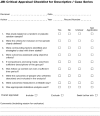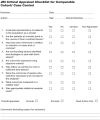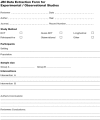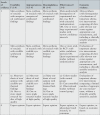Effects of foot and ankle devices on balance, gait and falls in adults with sensory perception loss: a systematic review
- PMID: 28009675
- PMCID: PMC5437711
- DOI: 10.11124/JBISRIR-2016-003229
Effects of foot and ankle devices on balance, gait and falls in adults with sensory perception loss: a systematic review
Abstract
Background: Foot and ankle devices are being developed as a method of preventing people with sensory perception loss sustaining a fall. Such devices are believed to work by reducing the likelihood of a fall by improving the balance and gait of the user.
Objectives: The objective of the review was to evaluate the effectiveness of foot and ankle devices for the prevention of falls and the improvement of balance and gait in adults with sensory perception loss.
Inclusion criteria types of participants: Participants were community-dwelling adults with bilateral pathological sensory perception loss.
Types of intervention(s)/phenomena of interest: The current review evaluated any foot or ankle device, including but not restricted to, all types of footwear (therapeutic and retail), insoles (customized and prefabricated) and ankle-foot orthoses (AFOs).
Types of studies: In the absence of randomized controlled trials (RCT), the review considered experimental and epidemiological study designs, except case series, individual case reports and descriptive cross-sectional studies.
Outcomes: The primary outcome was number of falls. Secondary outcome measures were clinical or laboratory measures of balance or gait.
Search strategy: A search for published and unpublished literature from inception to March 2015 written in the English language was conducted across a number of major electronic databases. A three-step search strategy was developed using MeSH terminology and keywords to ensure all that relevant materials are captured.
Methodological quality: Methodological quality of included studies was assessed by two reviewers, who appraised each study independently, using standardized Joanna Briggs Institute (JBI) critical appraisal tools.
Data extraction: Quantitative data were extracted from the studies that were identified as meeting the criteria for methodological quality using the standardized JBI data extraction tools.
Data synthesis: Due to the heterogeneity of populations, interventions and outcome measures, meta-analyses were not possible and results are presented in narrative form.
Results: Nine trials (from 10 papers) involving 238 participants, (14 with multiple sclerosis and 16 with idiopathic peripheral neuropathy, 150 with diabetic neuropathy) and 58 controls were included in the review. No study reported falls as an outcome measure. The results of the included studies found that in people with sensory perception loss, postural sway improved with vibrating insoles and AFO, altering the softness and texture of the top cover had no effect on postural sway, wearing footwear over long distances or AFOs improved step-to-step consistency, and no foot and ankle device was reported to have a negative effect on the balance or gait of people with sensory perception loss. The methodological quality of the included studies was poor. No study used a randomized controlled trial (RCT) methodology. No study incorporated a follow-up period or tested the intervention within the context of the intended clinical environment.
Conclusion: There is limited evidence to suggest that footwear and insole devices can artificially alter postural stability and may reduce the step-to-step variability in adults with sensory perception loss. Varying the material properties of an insole does not notably affect static balance or gait.
Conflict of interest statement
There is no conflict of interest in this project.
Figures
Similar articles
-
Folic acid supplementation and malaria susceptibility and severity among people taking antifolate antimalarial drugs in endemic areas.Cochrane Database Syst Rev. 2022 Feb 1;2(2022):CD014217. doi: 10.1002/14651858.CD014217. Cochrane Database Syst Rev. 2022. PMID: 36321557 Free PMC article.
-
The Effectiveness of Integrated Care Pathways for Adults and Children in Health Care Settings: A Systematic Review.JBI Libr Syst Rev. 2009;7(3):80-129. doi: 10.11124/01938924-200907030-00001. JBI Libr Syst Rev. 2009. PMID: 27820426
-
Footwear, Orthoses, and Insoles and Their Effects on Balance in Older Adults: A Scoping Review.Gerontology. 2024;70(8):801-811. doi: 10.1159/000539591. Epub 2024 Jun 5. Gerontology. 2024. PMID: 38838650
-
Interventions to reduce the incidence of falls in older adult patients in acute care hospitals: a systematic review.JBI Libr Syst Rev. 2009;7(21):942-974. doi: 10.11124/01938924-200907210-00001. JBI Libr Syst Rev. 2009. PMID: 27820548
-
The effect of ankle-foot orthoses on gait characteristics in people with Charcot-Marie-Tooth disease: A systematic review and meta-analysis.J Foot Ankle Res. 2024 Sep;17(3):e70003. doi: 10.1002/jfa2.70003. J Foot Ankle Res. 2024. PMID: 39276325 Free PMC article.
Cited by
-
Evaluation of the use of therapeutic footwear in people with diabetes mellitus - a scoping review.J Diabetes Metab Disord. 2019 Aug 14;18(2):613-624. doi: 10.1007/s40200-019-00428-9. eCollection 2019 Dec. J Diabetes Metab Disord. 2019. PMID: 31890687 Free PMC article.
-
Objectifying clinical gait assessment: using a single-point wearable sensor to quantify the spatiotemporal gait metrics of people with lumbar spinal stenosis.J Spine Surg. 2021 Sep;7(3):254-268. doi: 10.21037/jss-21-16. J Spine Surg. 2021. PMID: 34734130 Free PMC article.
-
Textured shoe insoles to improve balance performance in adults with diabetic peripheral neuropathy: study protocol for a randomised controlled trial.BMJ Open. 2019 Jul 17;9(7):e026240. doi: 10.1136/bmjopen-2018-026240. BMJ Open. 2019. PMID: 31320345 Free PMC article.
-
The influence of insoles with a peroneal pressure point on the electromyographic activity of tibialis anterior and peroneus longus during gait.J Foot Ankle Res. 2016 Aug 22;9(1):33. doi: 10.1186/s13047-016-0162-5. eCollection 2016. J Foot Ankle Res. 2016. PMID: 27555883 Free PMC article. Clinical Trial.
-
The effects of textured insoles on quiet standing balance in four stance types with and without vision.BMC Sports Sci Med Rehabil. 2019 Apr 4;11:5. doi: 10.1186/s13102-019-0117-9. eCollection 2019. BMC Sports Sci Med Rehabil. 2019. PMID: 30992992 Free PMC article.
References
-
- Citaker S, Gunduz AG, Guclu MB, Nazliel B, Irkec C, Kaya D. Relationship between foot sensation and standing balance in patients with multiple sclerosis. Gait Posture 2011; 34 2:275–278. - PubMed
-
- Mold JW, Vesley SK, Keyl BA, Schenk JB, Roberts M. The prevalence, predictors, and consequences of peripheral sensory neuropathy in older patients. J Am Board Fam Pract 2004; 17 5:309–318. - PubMed
-
- Vinik AI, Holland MT, Le Beau JM, Liuzzi FJ, Stansberry KB, Colen LB. Diabetic neuropathies. Diabetes Care 1992; 15 12:1926–1975. - PubMed
-
- Young MJ, Boulton AJM, Macleaod AF, Williams DDR, Sonkesn PH. A multicentre study of the prevalence of diabetic peripheral neuropathy in the United Kingdom hospital population. Diabetologia 1993; 36 2:150–154. - PubMed
-
- Richardson JK, Hurvitz EA. Peripheral neuropathy: a true risk factor for falls. J Gerontol 1995; 50A 4:M211–M215. - PubMed
Grants and funding
LinkOut - more resources
Full Text Sources
Other Literature Sources
Research Materials

















